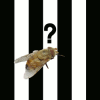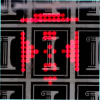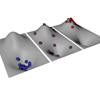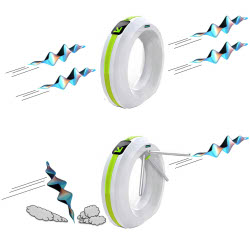-
Viewpoint on 'IONS'
Viewpoint on 'Scientific Literacy'
- Proudly sponsored by
-


-
Baffle the Bug!

Puzzled by the zebra’s appearance? Experimental data of recent research supports the idea that zebras developed their striped coat to stave off horseflies.
-
A Brighter Future for LED Displays

The displays of the future will be stretchable, twistable, deformable into any shape, and, perhaps more importantly, durable, efficient, and cheap. This is the promise of a new approach for manufacturing inorganic light emitting devices (ILEDs).
-
Hot Science Below Absolute Zero

Ultracold atoms afford scientists incredible control over the behavior of gas particles. And near impossible physics, in the form of negative absolute temperatures, for example, ensues!
Volume 15 Story 6 - 29/11/2011

Now also in Spanish
El rebotador de fotones
and Portuguese
O ricocheteador de fótons,
brought to you by
Optics and Photonics Latin America
For a bouncer, it is hard to split up a couple letting one in the club, and sending away the other. Similarly, for physicists, it is extremely difficult to bounce reliably exactly one unique single photon off a laser pulse. Serge Rosenblum and Barak Dayan from the Weizmann Institute of Science in Rehovo, Israel, and Scott Parkins from the University of Auckland in New Zealand have now shown how it is possible to successfully extract a single photon from a light pulse — a technique that may prove useful in developing future applications in quantum information processing.
To control single photons is the dream of many scientists working in quantum optics, because photons can encode qubits, the building blocks of quantum information technology. Alas, reliable single photon sources are still elusive. This is why quantum information often depends on very weak laser pulses, where we can only control the average number of photons per pulse, but not their exact number. In quantum cryptography, for example, safety depends critically on having at most one photon per pulse; therefore, to prevent pulses from having more than one photon, the average is typically kept as low as 0.1, which significantly slows down the transmission speed. Clearly, quantum information processing would greatly benefit if we could generate single photons on demand.
One way to create a single photon source is to reflect exactly one unique single photon out of a laser pulse. Since 2004 several research groups have been able to demonstrate this very thing in extremely challenging experiments [1,2,3]. This effect is known as photon blockade, in close analogy to the Coulomb blockade, where the passage of an electron prevents the passage of subsequent electrons. Rosenblum, Parkins and Dayan have analyzed the theoretical foundations and limitations of the separation of a two-photon pulse into a reflected photon and a transmitted photon.
If what interests us is the control of single photons, then cavity quantum electrodynamics (QED) is a natural starting point. Cavity QED is the study of the interactions between atoms and light inside an optical cavity. A cavity is a device — two parallel mirrors, for example — where light can bounce back and forth and, therefore, be confined for a long time. The interaction between the atom and the light can be described using a two-level system, where the atom can go from its ground state to its excited state by absorbing a photon. Since the excited state is not stable, the atom will eventually decay to the ground state by emitting a photon.
"The two-level system acts like a photon bouncer with poor memory. It is never able to reliably split a two-photon pulse," Dayan explains. If the photons arrive in a broad pulse, one much later than the other, the bouncer may forget that the first photon has already been bounced and may also bounce the second one. In a more physical picture, the two-level system may have time enough to jump to its excited state by scattering the first photon, and to subsequently decay back to its ground state before the second photon arrives; the two-level system can then reflect the second photon as well. Conversely, if the two photons arrive in a very short pulse, neither of them may be bounced because the bouncer has not managed to block the entrance in time: the two-level system may not have time to respond at all. "The inherent relation," Dayan adds, "between this memory-time and the reaction-time, and thus the impossibility to construct a perfect single photon router, is related to the time-energy uncertainty principle and therefore cannot be avoided, not even by using entangled photons. Therefore, we need to look into a more complex model to achieve deterministic single photon routing."
In fact, Rosenblum, Parkins and Dayan have found a possible way around this problem, using a slightly more complex three-level system. A three-level system has two different ground states and only one excited state. It can be excited from the first ground state to the excited state; it will then decay to the second ground state; from this second ground state, however, it cannot be excited back to the original excited state. "The three-level system can act as a photon bouncer with near-perfect memory," Dayan continues. "Intuitively speaking, a three-level system can have independent reaction and memory times, while a two-level system cannot. Thus, perfect single photon generation can be achieved because the system remembers that it already accepted one photon. In this way, we can devise a system that quickly accepts a photon, but then stays in the second ground state for a long time — which is like having a mirror that becomes opaque after having reflected one photon, which is just what we need to build our router."
"Over the next years," comments Arno Rauschenbeutel from the Technical University in Vienna, Austria, "I see a good chance that we will be able to introduce highly efficient nonlinearities at the single photon level using systems like the ones considered by Dayan and colleagues. If controlled at the quantum level and if performed with sufficiently high fidelity, such photon-photon interactions may well allow us to turn optical quantum information processing into a scalable technology, thereby opening the route towards, for example, the implementation of an optical quantum computer. In addition to these possible technological applications, quantum switches for light are also fascinating for fundamental science. In particular, they would enable the generation of so-called Schrödinger cat states of light, where a classical light pulse is prepared in a quantum superposition of two pulses propagating in two distinct directions. The study of such highly non-classical and non-local states will then shed light on the boundary between the quantum and the classical world."
[1] K. Birnbaum et al., Photon blockade in an optical cavity with one trapped atom, Nature 436, 87-90 (2005).
[2] B. Dayan et al., A Photon Turnstile Dynamically Regulated by One Atom, Science 319, 1062-1065 (2008).
[3] A. Faraon et al., Coherent generation of non-classical light on a chip via photon-induced tunnelling and blockade, Nature Physics 4, 859-863 (2008).

The Photon Bouncer
Technology based on individual photons may soon open the door to new ways of quantum computing. Controlling quantum systems, however, is extremely subtle and difficult. The most common model currently in use, as it now turns out, is simply insufficient — a slightly more complex approach is required.
Artistic representation of a photon router. Top: Without a photon router, the photon pairs pass unobstructed. Bottom: With the photon router, one photon of each pulse is reflected and the other photon passes.
El rebotador de fotones
and Portuguese
O ricocheteador de fótons,
brought to you by
Optics and Photonics Latin America
For a bouncer, it is hard to split up a couple letting one in the club, and sending away the other. Similarly, for physicists, it is extremely difficult to bounce reliably exactly one unique single photon off a laser pulse. Serge Rosenblum and Barak Dayan from the Weizmann Institute of Science in Rehovo, Israel, and Scott Parkins from the University of Auckland in New Zealand have now shown how it is possible to successfully extract a single photon from a light pulse — a technique that may prove useful in developing future applications in quantum information processing.
To control single photons is the dream of many scientists working in quantum optics, because photons can encode qubits, the building blocks of quantum information technology. Alas, reliable single photon sources are still elusive. This is why quantum information often depends on very weak laser pulses, where we can only control the average number of photons per pulse, but not their exact number. In quantum cryptography, for example, safety depends critically on having at most one photon per pulse; therefore, to prevent pulses from having more than one photon, the average is typically kept as low as 0.1, which significantly slows down the transmission speed. Clearly, quantum information processing would greatly benefit if we could generate single photons on demand.
One way to create a single photon source is to reflect exactly one unique single photon out of a laser pulse. Since 2004 several research groups have been able to demonstrate this very thing in extremely challenging experiments [1,2,3]. This effect is known as photon blockade, in close analogy to the Coulomb blockade, where the passage of an electron prevents the passage of subsequent electrons. Rosenblum, Parkins and Dayan have analyzed the theoretical foundations and limitations of the separation of a two-photon pulse into a reflected photon and a transmitted photon.
If what interests us is the control of single photons, then cavity quantum electrodynamics (QED) is a natural starting point. Cavity QED is the study of the interactions between atoms and light inside an optical cavity. A cavity is a device — two parallel mirrors, for example — where light can bounce back and forth and, therefore, be confined for a long time. The interaction between the atom and the light can be described using a two-level system, where the atom can go from its ground state to its excited state by absorbing a photon. Since the excited state is not stable, the atom will eventually decay to the ground state by emitting a photon.
"The two-level system acts like a photon bouncer with poor memory. It is never able to reliably split a two-photon pulse," Dayan explains. If the photons arrive in a broad pulse, one much later than the other, the bouncer may forget that the first photon has already been bounced and may also bounce the second one. In a more physical picture, the two-level system may have time enough to jump to its excited state by scattering the first photon, and to subsequently decay back to its ground state before the second photon arrives; the two-level system can then reflect the second photon as well. Conversely, if the two photons arrive in a very short pulse, neither of them may be bounced because the bouncer has not managed to block the entrance in time: the two-level system may not have time to respond at all. "The inherent relation," Dayan adds, "between this memory-time and the reaction-time, and thus the impossibility to construct a perfect single photon router, is related to the time-energy uncertainty principle and therefore cannot be avoided, not even by using entangled photons. Therefore, we need to look into a more complex model to achieve deterministic single photon routing."
In fact, Rosenblum, Parkins and Dayan have found a possible way around this problem, using a slightly more complex three-level system. A three-level system has two different ground states and only one excited state. It can be excited from the first ground state to the excited state; it will then decay to the second ground state; from this second ground state, however, it cannot be excited back to the original excited state. "The three-level system can act as a photon bouncer with near-perfect memory," Dayan continues. "Intuitively speaking, a three-level system can have independent reaction and memory times, while a two-level system cannot. Thus, perfect single photon generation can be achieved because the system remembers that it already accepted one photon. In this way, we can devise a system that quickly accepts a photon, but then stays in the second ground state for a long time — which is like having a mirror that becomes opaque after having reflected one photon, which is just what we need to build our router."
"Over the next years," comments Arno Rauschenbeutel from the Technical University in Vienna, Austria, "I see a good chance that we will be able to introduce highly efficient nonlinearities at the single photon level using systems like the ones considered by Dayan and colleagues. If controlled at the quantum level and if performed with sufficiently high fidelity, such photon-photon interactions may well allow us to turn optical quantum information processing into a scalable technology, thereby opening the route towards, for example, the implementation of an optical quantum computer. In addition to these possible technological applications, quantum switches for light are also fascinating for fundamental science. In particular, they would enable the generation of so-called Schrödinger cat states of light, where a classical light pulse is prepared in a quantum superposition of two pulses propagating in two distinct directions. The study of such highly non-classical and non-local states will then shed light on the boundary between the quantum and the classical world."
[1] K. Birnbaum et al., Photon blockade in an optical cavity with one trapped atom, Nature 436, 87-90 (2005).
[2] B. Dayan et al., A Photon Turnstile Dynamically Regulated by One Atom, Science 319, 1062-1065 (2008).
[3] A. Faraon et al., Coherent generation of non-classical light on a chip via photon-induced tunnelling and blockade, Nature Physics 4, 859-863 (2008).
Armand Niederberger
2011 © Optics & Photonics Focus
AN is a SU2P Research Fellow working on quantum networks at Stanford University, California, USA.

Serge Rosenblum, Scott Parkins & Barak Dayan, Photon routing in cavity QED: Beyond the fundamental limit of photon blockade, Physical Review A (2011) 84, 033854 (link).